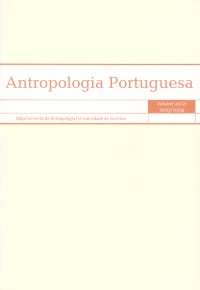Please use this identifier to cite or link to this item:
https://hdl.handle.net/10316.2/29367| DC Field | Value | Language |
|---|---|---|
| dc.contributor.author | Lessa, Andrea | - |
| dc.contributor.author | Souza, Sheila Mendonça de | - |
| dc.date.accessioned | 2014-02-12T16:09:23Z | |
| dc.date.accessioned | 2020-09-15T08:02:35Z | - |
| dc.date.available | 2014-02-12T16:09:23Z | |
| dc.date.available | 2020-09-15T08:02:35Z | - |
| dc.date.issued | 2004 | - |
| dc.identifier.issn | 2182-7982 | - |
| dc.identifier.uri | https://hdl.handle.net/10316.2/29367 | - |
| dc.description.abstract | The paleopathology of acute trauma in human bones from Solcor 3, San Pedro de Atacama, Chile, is used here to test the hypothesis of increasing physical stress during the period of increasing Tiwanaku socioeconomic influence at this desert oasis. The 64 best preserved skeletons from intact and culturally well defined tombs constituted a balanced sample of men and women from both periods, Tiwanaku and Pre-Tiwanaku. All of the macroscopic sequelae of trauma have been identified and quantified. Those skeletons that showed lesions typical of violence (skull fractures, arrow points embedded in bones, and parry fractures) were eliminated to avoid possible bias in the interpretation of atypical fractures. The prevalence of non-violent fractures was 41,2% (men) and 53,8% (women) in the Pre-Tiwanaku period and 23,5 % (men) and 35,3% (women) under the influence of Tiwanaku. The prevalence of fractures increased with age. During the Pre-Tiwanaku period the most common fractured bones for men were vertebrae and for women, ribs; this pattern is consistent with falls and physical injuries associated with carrying loads and herding animals. During the Tiwanaku period the same prevalence of vertebrae fractures, associated with high mortality in young adults, as well as the increase in vertebral fractures in women suggest that physical stress, as well as risk of falls, had increased. Otherwise, the rise in violent trauma in men and the disappearance of chest fractures in women suggest that habits, activities and risks for both sexes were also changing. The results confirm that transporting loads in packs and traveling may have intensified but also that a change in men’s and women’s activities was in process, at least in this Solcor 3 population. | eng |
| dc.description.abstract | O estudo paleopatológico dos traumatismos agudos em ossos humanos pré-históricos do cemitério Solcor 3, San Pedro de Atacama, Chile, permitiu discutir a hipótese de aumento do esforço físico, durante o período de aquecimento econômico, associado à penetração Tiwanaku no deserto. Um conjunto de 64 esqueletos bem contextualizados, subdivididos em séries equilibradas de homens e mulheres adultos, representando dois períodos, Pré-Tiwanaku e Tiwanaku, tiveram todas as seqüelas macroscópicas de fraturas identificadas e quantificadas. Eliminados os prováveis casos resultantes de violência (fraturas de crânio, pontas de flechas em ossos e fraturas de Parry), foram encontradas lesões em 41,2% dos homens e 53,8% das mulheres Pré-Tiwanaku, e em 23,5% dos homens e 35,3% das mulheres Tiwanaku, com aumento da prevalência no grupo mais idoso, tal como esperado. As lesões mais freqüentes nos homens do período Pré-Tiwanaku foram vertebrais, e nas mulheres foram nas costelas, o que é compatível, respectivamente, com quedas e esforços associados ao transporte de cargas, com o manejo de cargas e de animais, além de possível violência doméstica. A manutenção da mesma prevalência de fraturas vertebrais em homens Tiwanaku, associada à sobremortalidade de jovens, bem como o aumento das mesmas fraturas em mulheres, sugerem posterior aumento de exposição a tais acidentes. Ainda no período Tiwanaku, o aumento de violência entre homens e a ausência de fraturas de tórax nas mulheres, sugerem mudanças na conduta, nas atividades e na exposição aos riscos para aquela população. Os resultados levam a concluir que a transição entre os dois períodos teria sido acompanhada de provável intensificação de atividades relacionadas ao tráfego e manejo de cargas, ao mesmo tempo em que se processava uma mudança de papeis desempenhados por homens e mulheres, pelo menos para este grupo do cemitério Solcor 3. | por |
| dc.language.iso | por | - |
| dc.publisher | CIAS - Centro de Investigação em Antropologia e Saúde | - |
| dc.rights | open access | - |
| dc.subject | Paleoepidemiology | eng |
| dc.subject | acute trauma | eng |
| dc.subject | accident | eng |
| dc.subject | San Pedro de Atacama | eng |
| dc.subject | Tiwanaku | eng |
| dc.subject | Paleoepidemiologia | por |
| dc.subject | traumas agudos | por |
| dc.subject | acidentes | por |
| dc.subject | San Pedro de Atacama | por |
| dc.subject | Tiwanaku | por |
| dc.title | Paleoepidemiologia dos traumatismos cotidianos em Solcor 3, San Pedro de Atacama, Chile: riscos diferenciados no período Tiwanaku? | por |
| dc.type | article | - |
| uc.publication.collection | Antropologia Portuguesa vol. 20/21 | - |
| uc.publication.firstPage | 183 | - |
| uc.publication.lastPage | 207 | - |
| uc.publication.location | Coimbra | - |
| uc.publication.journalTitle | Antropologia Portuguesa | - |
| uc.publication.volume | 20/21 | por |
| uc.publication.section | Vária | - |
| uc.publication.digCollection | IP | - |
| uc.publication.digCollection | B1 | - |
| uc.publication.orderno | 9 | - |
| uc.publication.area | Ciências Sociais | - |
| uc.publication.manifest | https://dl.uc.pt/json/iiif/10316.2/29367/215574/manifest?manifest=/json/iiif/10316.2/29367/215574/manifest | - |
| uc.publication.thumbnail | https://dl.uc.pt/retrieve/11236222 | - |
| uc.itemId | 71232 | - |
| uc.thumbnail.uri | https://dl.uc.pt/iiif-imgsrv/11236170/dl!3!45!56!61!45566152513490600119519768821938628851 | - |
| item.grantfulltext | open | - |
| item.fulltext | With Fulltext | - |
| Appears in Collections: | Antropologia Portuguesa | |
Files in This Item:
| File | Description | Size | Format | |
|---|---|---|---|---|
| ap20-21_artigo9.pdf | 837.01 kB | Adobe PDF |  |
Items in DSpace are protected by copyright, with all rights reserved, unless otherwise indicated.
